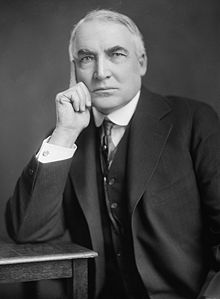
"Return to normalcy" was a campaign slogan used by Warren G. Harding during the 1920 United States presidential election. Harding won the election with 60.4% of the popular vote.

"Return to normalcy" was a campaign slogan used by Warren G. Harding during the 1920 United States presidential election. Harding won the election with 60.4% of the popular vote.
In a speech delivered on May 14, 1920, Harding proclaimed that America needed "not nostrums, but normalcy". [1] Two months later, during a homecoming speech, Harding reaffirmed his endorsement of "normal times and a return to normalcy." [2]
World War I and the Spanish flu had upended life, and Harding said that it altered the perspective of humanity. He argued that the solution was to seek normalcy by restoring life to how it was before the war. [3] Harding's conception of normalcy for the 1920s included deregulation, civic engagement, and isolationism. [3] He rejected the idealism of Woodrow Wilson and the activism of Roosevelt, favoring the earlier isolationist policy of the United States. [4]
Detractors of the time tried to belittle the word "normalcy" as a neologism as well as a malapropism, saying that it was poorly coined by Harding, as opposed to the more accepted term normality . There was contemporaneous discussion and evidence that normalcy had been listed in dictionaries as far back as 1857. [5] According to some historians, normalcy was an "obscure math term" before its use by Harding [6] during the campaign. Harding, a newspaper editor, addressed the issue of the word's origin, claiming that normalcy but not normality appeared in his dictionary. [7]
Harding's position attracted support during the 1920 presidential election, winning 60.3% of the popular vote. [8]
Chalmers M. Roberts of The Washington Post compared the desire for a "return to normalcy" in 1920 to the 1946 midterms following World War II and the 1992 presidential election following the Cold War. [9]
The 12th episode of Boardwalk Empire takes place during the 1920 election and is titled "A Return to Normalcy".
The phrase "return to normalcy" became associated with the 2020 presidential campaign of Joe Biden, specifically referring to Biden's promises to end the "divisiveness of the Trump years," as well as his campaign's focus on tackling the COVID-19 pandemic in the United States. [10]

Warren Gamaliel Harding was the 29th president of the United States, serving from 1921 until his death in 1923. A member of the Republican Party, he was one of the most popular sitting U.S. presidents. After his death, a number of scandals were exposed, including Teapot Dome, as well as an extramarital affair with Nan Britton, which tarnished his reputation.
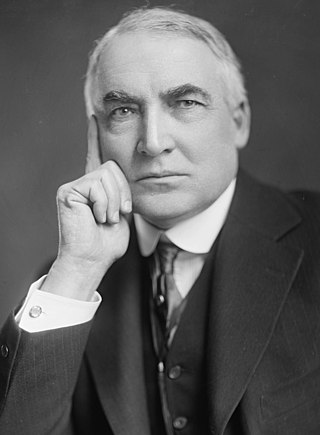
The 1920 United States presidential election was the 34th quadrennial presidential election, held on Tuesday, November 2, 1920. In the first election held after the end of the First World War and the first election after the ratification of the Nineteenth Amendment, Republican Senator Warren G. Harding of Ohio defeated Democratic Governor James M. Cox of Ohio. It was one of only six presidential elections where both major candidates had the same home state.

James Monroe Cox was an American businessman and politician who served as the 46th and 48th governor of Ohio, and a two-term U.S. Representative from Ohio. As the Democratic nominee for President of the United States at the 1920 presidential election, he lost in a landslide to fellow Ohioan Warren G. Harding. His running mate was future president Franklin D. Roosevelt. He founded the chain of newspapers that continues today as Cox Enterprises, a media conglomerate.
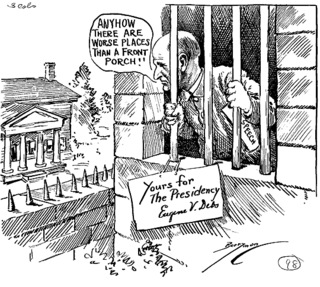
A front porch campaign is a low-key electoral campaign used in American politics in which the candidate remains close to or at home to make speeches to supporters who come to visit. The candidate largely does not travel around or otherwise actively campaign. The successful presidential campaigns of James A. Garfield in 1880, Benjamin Harrison in 1888, and William McKinley in 1896 are perhaps the best-known front porch campaigns.

Warren G. Harding's tenure as the 29th president of the United States lasted from March 4, 1921, until his death on August 2, 1923. Harding presided over the country in the aftermath of World War I. A Republican from Ohio, Harding held office during a period in American political history from the mid-1890s to 1932 that was generally dominated by his party. He died of an apparent heart attack and was succeeded by Vice President Calvin Coolidge.
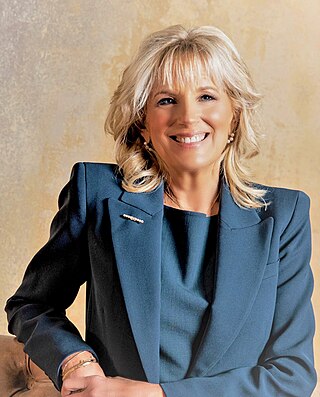
Jill Tracy Jacobs Biden is an American educator who has been the first lady of the United States since 2021 as the wife of President Joe Biden. She was the second lady of the United States from 2009 to 2017 when her husband was vice president. Since 2009, Biden has been a professor of English at Northern Virginia Community College, and is believed to be the first wife of a vice president or president to hold a salaried position during the majority of her husband's tenure.

"A Return to Normalcy" is the 12th episode of the first season of HBO television series Boardwalk Empire and the season finale, which premiered on HBO December 5, 2010. The episode was written by series creator Terence Winter and directed by Tim Van Patten, both executive producers.

The 1920 United States elections was held on November 2. In the aftermath of World War I, the Republican Party re-established the dominant position it lost in the 1910 and 1912 elections. This was the first election after the ratification of the 19th Amendment, which granted women the constitutional right to vote.

The 1920 United States presidential election in New Mexico took place on November 2, 1920. All contemporary forty-eight States were part of the 1920 United States presidential election. Voters chose three electors to represent them in the Electoral College, which voted for President and Vice President.

The 1920 United States presidential election in New York took place on November 2, 1920. All contemporary 48 states were part of the 1920 United States presidential election. Voters chose 45 electors to the Electoral College, which selected the president and vice president.

The 1920 United States presidential election in Massachusetts took place on November 2, 1920, as part of the 1920 United States presidential election, which was held throughout all contemporary 48 states. Voters chose 18 representatives, or electors to the Electoral College, who voted for president and vice president.

The 1920 United States presidential election in New Jersey took place on November 2, 1920. All contemporary 48 states were part of the 1920 United States presidential election. Voters chose 14 electors to the Electoral College, which selected the president and vice president.
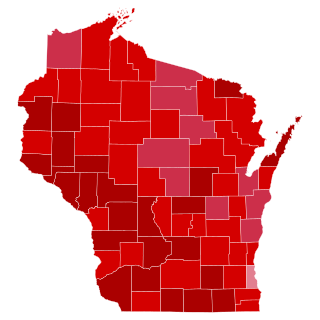
The 1920 United States presidential election in Wisconsin was held on November 2, 1920, as part of the 1920 United States presidential election. State voters chose 13 electors to the Electoral College, who voted for president and vice president.

The 1920 United States presidential election in Minnesota took place on November 2, 1920 as part of the 1920 United States presidential election in which all contemporary forty-eight states participated. Voters chose 12 electors, or representatives to the Electoral College, who voted for president and vice president. This election marks the last time a candidate for president won every county in Minnesota.
Social media was used extensively in the 2020 United States presidential election. Both incumbent president Donald Trump and Democratic Party nominee Joe Biden's campaigns employed digital-first advertising strategies, prioritizing digital advertising over print advertising in the wake of the pandemic. Trump had previously utilized his Twitter account to reach his voters and make announcements, both during and after the 2016 election. The Democratic Party nominee Joe Biden also made use of social media networks to express his views and opinions on important events such as the Trump administration's response to the COVID-19 pandemic, the protests following the murder of George Floyd, and the controversial appointment of Amy Coney Barrett to the Supreme Court.

The 1920 United States presidential election in South Dakota took place on November 2, 1920 as part of the 1920 United States presidential election in which all contemporary forty-eight states participated. Voters chose five electors, or representatives to the Electoral College, who voted for president and vice president.
The following is a timeline of major events leading up and during the 2020 United States presidential election, the 59th quadrennial United States presidential election, from January to October 2020. For previous events, see Timeline of the 2020 United States presidential election (2017–2019). For subsequent events, see Timeline of the 2020 United States presidential election